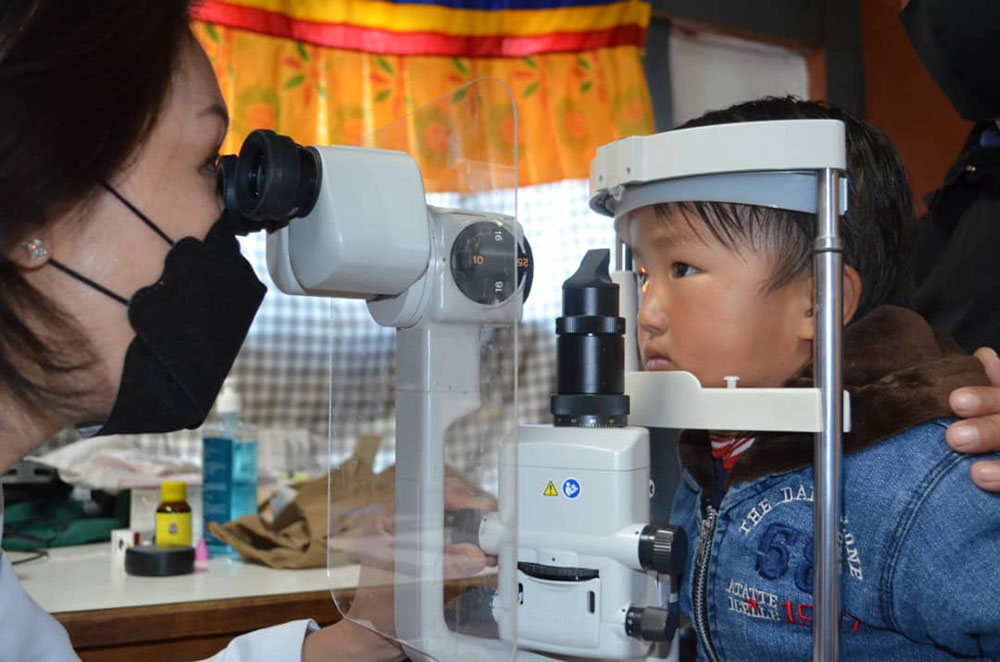Nima Wangdi
Myopia in children is on the rise in the country, according to ophthalmologists at the Jigme Dorji Wangchuk National Referral Hospital (JDWNRH) in Thimphu.
Myopia is a common refractive error in which the near vision is clear while distant vision is blurred. Myopia is also known as nearsightedness.
Paediatric Ophthalmologist Dr Dechen Wangmo said the patient load has increased from 4,000 to 5000 per month a few years ago to about 9,000 per month now.
“This means the ophthalmologists are attending to 300 patients every day in the hospital,” she said.
She said that myopia is increasing in many other Asian countries. “We are seeing the same case here since we share similar parenting behaviours with the rest of the Asian countries.”
What causes Myopia?
Myopia worldwide is caused mainly due to “near work”.
Near work among the children in Bhutan is also increasing from a very young age, according to Doctor Dechen Wangmo. “Near work means looking at devices like TVs, laptops, mobile phones, and books close to your eyes.”
She also said other reasons for the increase could be because of increased awareness among parents who in turn bring their children to the hospital for check-ups.
Explaining how it is caused, the ophthalmologist said anything that is a near device causes the eye to physiologically get a little longer over time, and the condition is called physiologic myopia. “The environmental stimulus that we are subjecting our eyes to changes the development of the eye so that in the long term, children develop myopia,” she explained.
The Bhutan School Sight Survey (BSSS 2019) conducted in 2019 covered 190 schools and over 5,000 students in the age range of 5 to 10 years. “Over six percent of the students were diagnosed with myopia,” she said.
According to the survey findings, myopia was found to be more common among the students in urban areas than those in rural areas. It was also more prevalent among females over males, and among children whose parents have higher education levels.
“Going by the science, this could be because the children in urban schools are engaged more in indoor activities, unlike those in the rural areas,” she said. “Children of parents with a higher level of education are also focused more on academics while children in rural settings spend more time doing outdoor tasks helping their parents.”
She also claimed that the case among the female students is high because girls in Bhutan usually tend to do fewer outdoor activities.
Doctor Dechen said that having realized these factors, schools in other countries are cutting down on indoor activities and encouraging outdoor activities. “Besides myopia, children also suffer eye infections, cataracts, glaucoma, corneal scars, and squints. If not corrected on time, these factors could lead to poor visual output,” she said.
Solution
Dr Dechen Wangmo said myopia is a common problem and it requires only a pair of the right glasses for the right reason. “It is also important that the children be brought to the hospital for eye checks, irrespective of their age. The professionals can check a baby’s eyes as early as right after they are born.”
She said babies could neither complain about their eyesight nor understand them. “But it is the responsibility of the caregivers to bring them to the hospital for a check up on time. Late diagnosis and treatment will fail to obtain an optimal outcome.”
Ophthalmologists said that failing to get eye issues checked and corrected on time would lead to the condition known as amblyopia, a condition where eyes look normal but it would not function normally.
Dr Dechen said that many parents ask about permissible screen time for children, but there isn’t anything recommended in the world so far. “The world’s renowned academics like the American Academic for Paediatrics have recommended not giving any device to children below one year.”
She said that not all eyes are not suitable for contact lenses since they go with the shape of the eyes. “It could lead to eye infection and vision impairment if not consulting professionals before deciding to wear contact lenses.”
Dr Dechen said in the digital age, we should help our children grow with the devices. “There is a rule called ‘the 20-20-20 rule’, where you take a break every 20 minutes from the screen, rest for 20 seconds and look at an object 20 feet away.”
Meanwhile, a study conducted in 2020 has found that there is a rapid rise of myopia among school-age children in East and Southeast Asia over the last 60 years, which showed that the recent myopia boom is attributed primarily to the educational pressure in Asian countries, which prompts children to read for long hours, often under poor lighting, and on computer screens.
The study stated that the practice severely limits the time spent outdoors and reduces exposure to sunlight and far vision. “As a consequence, the eyes become myopic.”


